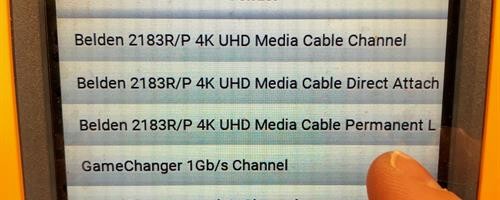
Testing versus Guessing
As we have discussed in our Lengthonomics blogs, there are many times that 100m of cabling is not enough to reach where the end device needs to reside. GameChanger was designed to extend the distance supported by a single length of cable for longer distance Ethernet and Power of Ethernet applications. This solution eliminates IDFs, additional devices (repeaters, extenders and transceivers) for lengths up to 850’ requiring 10Mb/s and PoE+ and lengths up to 656’ (200m) for 100Mb/s and Gigabit Ethernet and PoE+ applications supporting cameras, WAPs, additional switches, and other Ethernet IoT edge devices.
In the past, the addition of repeaters, extenders, and transceivers have made not only verification of the overall link, but troubleshooting of failed communications difficult at best. When additional devices are in line, they require various levels of expertise to troubleshoot. In the case of an inline repeater that is powered, an electrician, low voltage engineer, and network engineer may all be needed to troubleshoot the problem. Where multiple devices are inline, this could take hours. If one assumes that the hourly cost for the electrician is $100, low voltage contractor is $85, and a network technician is $125, the hourly cost for one hour of troubleshooting is $310.00. With inline powered devices, the electrician would only be needed if the end power is at fault. So the low voltage contractor and network engineer would be used for a combined total of $210 per hour.
One problem with inline repeaters/extenders is that they are not always clearly documented as to location and may get buried with subsequent layers of cable making them difficult to find. Often these trades work with a 3-hour minimum on-site fee, making a single failure’s price nearly $1,000 per hour when all three trades are used. To further complicate things, if multiple repeaters are inline, the number of reasons that a problem exist will be compounded by the number of components. Other things to consider will be time in lifts, up and down ladders, and should the cable be too short between components or if the repeaters can’t be found, the cost to replace the channel after troubleshooting efforts fail. With powered fiber cable, should either the copper side or fiber side fail, both would need to be replaced as it is a hybrid cable. And, of course, to be considered is the cost of downtime. With security cameras, downtime could be critical due to the lack of visibility to a monitored area.
Long ago, someone coined the acronym K.I.S.S. "Keep it simple" is true today. With GameChanger, it is simply a matter of running the channel. In the past, validation was determined by turning on a cable and making sure the end device had communication. Today, there are ways to test this long link. We are proud to announce that there are multiple ways to test the full channel, the latest of which is the Fluke DSX CableAnalyzer Series of testers and via upgrade to existing DSX users. The test takes 11 seconds and will certify that the cable will support the applications as intended. As a leading tester for the cabling industry, it was important to have our parameters in the Fluke tester. The simple run once, test and done makes the GameChanger tested with Fluke a simple turnover from the installer to the customer with printed validation that the link will work. Unlike other methods that don’t allow for end to end testing with all components in place, but rather testing channel components hoping the sum of all parts perform as intended. GameChanger and Fluke, it really is that simple. For a full list of supported testers contact Paige sales, visit our GameChanger landing page here.

